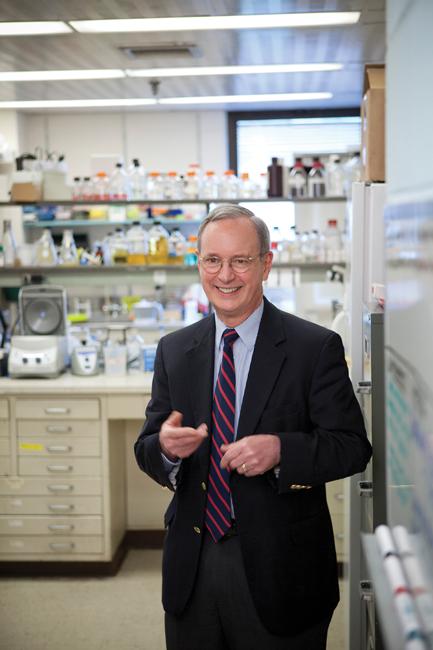Under the Radar
A vast network monitors the veiled movements of virulent pathogens

In the late summer of 1999, physicians in Queens, New York, confronted something out of the ordinary: patients with encephalitis and muscle weakness—and addresses notably near one another. Doctors were perplexed; there seemed to be no recognizable pathogen associated with the outbreak. Nearly a week after the first cases, and the first fatalities, the New York City Department of Health and the Centers for Disease Control and Prevention (CDC) identified what turned out to be West Nile virus. The news unnerved the infectious disease community: This was the first recorded appearance of West Nile virus in the United States.
“I canceled my trip to San Francisco,” says Alfred DeMaria ’74, state epidemiologist and medical director for the Bureau of Infectious Disease in Massachusetts. “I knew all hell was about to break loose even if the virus wasn’t in Massachusetts.”
And sure enough, the presence of West Nile virus shook, and continues to shake, the nation, with widespread spraying of insecticides aimed at killing virus-bearing mosquitoes and annual warnings urging people to protect themselves from insects carrying the virus.

In 1999 there were 62 cases and 7 deaths reported. In the years since the initial outbreak, incidence has varied, with 2003 representing a peak; the CDC registered nearly 10,000 cases and more than 260 deaths that year. In 2012, the CDC recorded 5,674 cases of West Nile virus disease, of which 51 percent were neuroinvasive, precipitating conditions such as meningitis or encephalitis. Although the incidence continues to dip, the annual number of deaths has seesawed: in 2012, 286 people succumbed to the disease, more than in the peak infection year of 2003.
In the nearly 14 years since West Nile came ashore, disease surveillance teams in the United States have had to address the appearance of other previously unknown pathogens, from the severe acute respiratory syndrome (SARS) virus of a decade ago to the new strains of influenza viruses that develop annually. While threats of fast-adapting and hard-to-stop bugs are common, what keeps the nation’s public health infrastructure from being overwhelmed is the information exchanged through an intricate and efficient network of physicians, infectious disease researchers, epidemiologists, and public health officials who survey, identify, and, when necessary, respond to emergent threats.
Who Are You?
The CDC and global health agencies such as the World Health Organization (WHO), as well as state and local public health units, have developed tools to monitor the spread of infectious disease. The WHO, for instance, supports the use of WHONET, a software project begun by Thomas O’Brien ’54, an HMS associate professor of medicine at Brigham and Women’s Hospital, and developed and distributed by John Stelling ’91, an HMS instructor in medicine at the hospital. The two researchers codirect the WHO Collaborating Centre for Surveillance of Antimicrobial Resistance.
WHONET changed the face of public health and disease surveillance by leveraging existing routine information resources available in microbiology laboratories worldwide.
“Doctors used to send samples to microbiology labs, which would then send the test results to public health departments,” says Stelling. “So public health officials would often know about a disease before doctors would.”
With WHONET, authorized users in more than 100 nations contribute to local, regional, and international databases for tracking microbial populations, including information on bacterial, fungal, and parasitic pathogens isolated in hospitalized and community-dwelling patients. This level of monitoring allows clinicians and epidemiologists to stay abreast of trends, point occurrences, and broad outbreaks.

WHONET has, for example, been useful for tracking in real time the global spread of carbapenem-resistant Enterobacteriaceae. The Enterobacteriaceae are a family of bacteria that include Escherichia coli and the Klebsiella species, normal inhabitants of the human gut. Resistance to the carbapenem family of antibiotics, last-line agents in the treatment of patients infected with multi-drug resistant, illness-causing gram-negative bacteria, is troubling—and often fatal. Of particular concern is that many of these infections are health care associated and attributable to the use of medical devices that raise the risk of infection, such as ventilators or intravenous and urinary catheters.
National Guard
A tool that has long been a touchstone for U.S. physicians and researchers is the CDC’s Morbidity and Mortality Weekly Report, which highlights disease trends, occurrences, and fatalities based on information collected from state departments of public health. In addition, the CDC houses departments responsible for infectious disease surveillance. Within its Office of Infectious Diseases, for instance, is the National Center for Emerging and Zoonotic Infectious Diseases, which tracks diseases that are passed to humans from animal sources.
The CDC has networks that connect state and regional public health organizations. And it has formed partnerships with the National Association of County and City Health Officials and the Association of State and Territorial Health Officials in order to share near real-time data. Overall, the goal is to maintain effective communication and preparedness at all levels of the public sector.
State departments of public health, in turn, have their own systems that allow clinicians, laboratory personnel, public health workers, and epidemiologists to report and share data. The Massachusetts Virtual Epidemiologic Network (MAVEN) has been the Commonwealth’s system since 2006.
“MAVEN allows public health officials to identify infectious diseases quickly,” says DeMaria. “Once the disease has been identified, a public health worker investigates to help prevent its spread.”
The system has been instrumental in improving the timeliness of the reporting of hepatitis A infections and, subsequently, the ability of public health officials to identify infected individuals who may be at risk for infecting others. Although MAVEN was developed to meet the specific needs of Massachusetts, other jurisdictions, including Connecticut, North Carolina, and New York City, have adopted the software.
Continental Drift
Although surveillance tools can help identify disease trends, what happens when a patient comes to a hospital with an unidentified illness?
“The first step in evaluation is to consider the history of the patient,” says David Hooper, an HMS professor of medicine and chief of the Infection Control Unit at Massachusetts General Hospital. “And in such cases, the person’s travel and exposure history and other medical conditions become important. The sicker the patient, the broader the range of things to consider, so a thorough history helps ensure we don’t miss something that could help with the diagnosis.”

“We also look closely at data from the microbiology lab to help identify the specific pathogens involved,” he adds. To illustrate, Hooper tells of a patient who was infected by a strain of bacteria that produces NDM-1, or New Delhi metallo-beta-lactamase-1, an enzyme that renders the bacteria resistant to many antibiotics, including those effective against gram-negative microbes. Many bacterial isolates with this resistance have arisen within populations in India.
A history revealed that the Mass General patient had in fact been hospitalized in India before returning to the United States. In addition, microbiologic analyses quickly identified the strain as one resistant to carbapenem antibiotics and, later, showed it was the NDM-1 “superbug.”
Once a resistant pathogen is identified and a treatment regimen initiated, Hooper’s focus shifts to containment. “We’re worried not only about the spread of a particular resistant bacteria between patients,” he says, “but also about the potential for patients to develop a hospital-acquired infection.”
It is estimated that hospital-acquired infections affect 1 of every 20 people admitted to hospitals nationwide. These infections include those associated with the use of medical devices. The bacteria that cause them can include methicillin-resistant Staphylococcus aureus (MRSA), vancomycin-resistant Enterococcus (VRE), and pathogens linked with respiratory infections such as pneumonia. Combating these infections can cost hospitals between $5 billion and $7 billion per year.
In a Lather
“There is a real public health crisis in this country,” says Erika D’Agata, an HMS associate professor of medicine at Beth Israel Deaconess Medical Center, “because since the 1970s, only three completely new antimicrobials have been introduced to market.”
D’Agata develops computational models that devise scenarios for controlling the rate of hospital-acquired infections. “We ask questions like, ‘What would happen if we decreased the use of antibiotics?’ or ‘What if everyone complied with handwashing guidelines?’ ”

One study by D’Agata found that compliance with handwashing guidelines among health care workers in a particular dialysis unit was approximately 40 percent. The corresponding rate of VRE in that unit hovered near 12 percent. A simulation by D’Agata, however, showed that 100 percent compliance would reduce that prevalence to 2.5 percent.
In order to focus on ways to judiciously use antibiotics, hospitals have begun to participate in antibiotic stewardship programs that monitor the use of the drugs. Driven by data provided by microbiology labs within the hospitals, the programs allow hospitals to monitor, analyze, and improve the ways antibiotics are used. Says Hooper, “We start collecting samples from the patient before anything is administered so we can ensure that the best treatment is chosen and so we can follow the trajectory of the disease and the patient’s response to treatment.”
Outside the Box
A concrete building in Jamaica Plain, Massachusetts, houses a welter of microbiology labs, each with technicians who monitor, identify, and record the movement of pathogens into and out of the Commonwealth.
“It’s the reports from these lab workers,” says DeMaria, “that help public health officials identify and investigate outbreaks and respond to them.”
The expertise of the laboratory personnel strengthens the surveillance system, more so because they communicate daily with epidemiologists. This type of exchange among clinicians and other relevant parties, says DeMaria, is also what makes the West Nile outbreak such a good example of the public health system at work.
“When we are doing our jobs well, you won’t even know we exist,” he says. “Pandemics and epidemics are inevitable. But how quickly we get to the bottom of them depends on how well we maintain this network of medical and public health professionals.”
Shraddha Chakradhar is a science writer based in Boston.